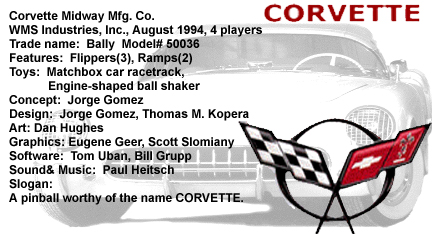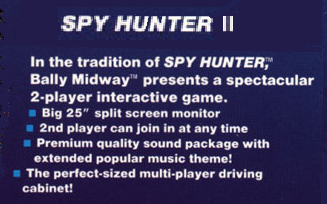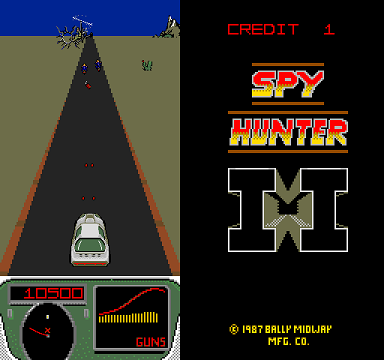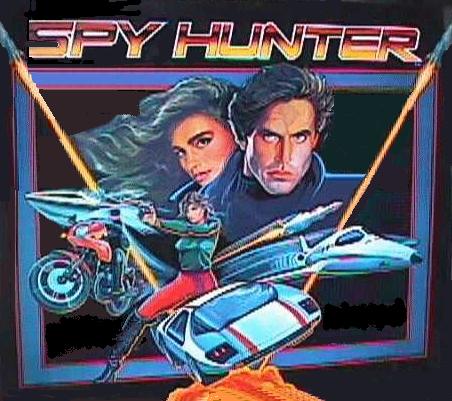Posted: December 3, 2004
A review of a Spy Hunter Champion Mark Little and George Gomez, Spy Hunter Developer George Gomez has developed many other Video Games like the Classic Tron Game.
Mark Little
Spy Hunter Articles


Spy Hunter Sit Down Driving Video Game (1983 Wide Release)
George Gomez Spy Hunter Developer, Biography

Some members of the Pinball 2000 design team with their first creation Left to right: Larry DeMar, Lyman F Sheats, George Gomez
-------------------------------------------------------------------------------- (George Gomez Seven Pinball Creations) 7 records Units Produced Link 1994-08 Corvette Midway SS 5,001 4p 1995-08 Johnny Mnemonic Williams SS 2,756 4p 1998-07 Monster Bash Williams SS 3,361 4p 1997-03 NBA Fastbreak Midway SS 4,414 4p 2002-01 Playboy Stern SS unlisted 4p 1999-01 Revenge From Mars Midway SS 6,878 4p 2003-12 The Lord of the Rings Stern SS 4,017 4p -------------------------------------------------------------------------------- George Gomez
Pinball Creations Johnny Mnemonic & NBA Fastbreak
George Gomez
Pinball Creation NBA Fastbreak NBA Fastbreak, notable because it's the first linked pinball machine.
George Gomez NBA Fastbreak Pinball Field Display High Score Content Originally From:
Link
Back to: Walter Day Conversations
Go to: Paul Dean Biography

 George Gomez - Pinball Expo 2004
i.e. Fireside Chat
The audience had been primed by Steve Ritchie and Ray Tanzer to fire rubber bands at
George as he began to speak. In retaliation, George showed this cartoon by Pat McMahon
of Steve as a slot machine designer.
When he left college George got a job working for Midway, originally in the mechanical
engineering department making control interfaces and cabinets and later working on
video game design. He worked on the Spy Hunter video game developing software and
designing controls. At night, he used to head over to the pinball division and play
their Firepower 2.
He spent seven years in the video game department but wanted to make something more
tangible and real, so he left to become a toy designer.
George played a slideshow of some of the toys he designed including Crash & Bash
(trucks that would crash into each other with various parts flying off) and Wearable
Warriors (a range of hi-tech watches and other jewelry with built-in gimmicks and
characters).
He said this work was fun and paved the way for this later work designing pinball
as he could understand how mechanisms worked and put things together.
How George's toy design skills complemented his pinball design
329KB MP3
George Gomez - Pinball Expo 2004
i.e. Fireside Chat
The audience had been primed by Steve Ritchie and Ray Tanzer to fire rubber bands at
George as he began to speak. In retaliation, George showed this cartoon by Pat McMahon
of Steve as a slot machine designer.
When he left college George got a job working for Midway, originally in the mechanical
engineering department making control interfaces and cabinets and later working on
video game design. He worked on the Spy Hunter video game developing software and
designing controls. At night, he used to head over to the pinball division and play
their Firepower 2.
He spent seven years in the video game department but wanted to make something more
tangible and real, so he left to become a toy designer.
George played a slideshow of some of the toys he designed including Crash & Bash
(trucks that would crash into each other with various parts flying off) and Wearable
Warriors (a range of hi-tech watches and other jewelry with built-in gimmicks and
characters).
He said this work was fun and paved the way for this later work designing pinball
as he could understand how mechanisms worked and put things together.
How George's toy design skills complemented his pinball design
329KB MP3  George Gomez Developed Battle Tech Player Pods
He came up with this concept for the player pod which was installed in their locations
for six months until the client company's constant late or non-payments caused George
to leave.
He then designed a number of novelty games for Bromley, one of which was noticed by Pat
Lawlor and Larry DeMar at an AMOA trade show. That recognition was to prove valuable a
couple of years later when a position opened up at Williams for a novelty game designer.
Also while making novelty games for Bromley, George was at an arcade when they brought
in a Terminator 2 pinball on test. He was getting frustrated with the restricted number
of features he could put in his games so when this new pinball showed up he tried it and
realized he could design these games too.
How George started making pinball games
447KB MP3
George Gomez Developed Battle Tech Player Pods
He came up with this concept for the player pod which was installed in their locations
for six months until the client company's constant late or non-payments caused George
to leave.
He then designed a number of novelty games for Bromley, one of which was noticed by Pat
Lawlor and Larry DeMar at an AMOA trade show. That recognition was to prove valuable a
couple of years later when a position opened up at Williams for a novelty game designer.
Also while making novelty games for Bromley, George was at an arcade when they brought
in a Terminator 2 pinball on test. He was getting frustrated with the restricted number
of features he could put in his games so when this new pinball showed up he tried it and
realized he could design these games too.
How George started making pinball games
447KB MP3  So that concludes our report from the two fireside chats. It's clear that they have
outgrown the confines of Rob's hotel room but in moving to the Grand Ballroom they have
also lost much of the intimacy and become more like seminars which is a shame because
part of the attraction of the format was the informality, most of which has been lost.
But that said, this year's guests provided some excellent entertainment and some
interesting insights into the design processes and methodology from some of pinball's
greatest designers of recent years. But that wasn't the end of the talks because squeezed
into the schedule on Saturday afternoon was a late seminar by another great pinball
artist.
--------------------------------------------------------------------------------------
lead designer George Gomez talk about their iced out one-on-one basketball game.
NBA Ballers: George Gomez Interview
So that concludes our report from the two fireside chats. It's clear that they have
outgrown the confines of Rob's hotel room but in moving to the Grand Ballroom they have
also lost much of the intimacy and become more like seminars which is a shame because
part of the attraction of the format was the informality, most of which has been lost.
But that said, this year's guests provided some excellent entertainment and some
interesting insights into the design processes and methodology from some of pinball's
greatest designers of recent years. But that wasn't the end of the talks because squeezed
into the schedule on Saturday afternoon was a late seminar by another great pinball
artist.
--------------------------------------------------------------------------------------
lead designer George Gomez talk about their iced out one-on-one basketball game.
NBA Ballers: George Gomez Interview  George Gomez: I worked on TRON and the original Spy hunter back in the '80s. I
designed toys for 5 years and I designed Pinball machines for 6 years.
NBA Ballers plays like much more than a one-on-one basketball game. Describe
the elements which make Ballers as much about the lifestyle as it is about the
on-court action.
George Gomez: Well what we wanted to do was to create a level of character
distinction similar to a fighting game. Where there was much more than just
attributes to differentiate players. We did this with the Specials and the
move sets. The lifestyle elements were a natural component. The lifestyle
elements made it easy for us to distinguish our game from all of the other
basketball games out there. We have the rides, the cribs, the crews, the ice,
tats, kicks, and fashion to really set your ballers apart from all the rest.
George Gomez: I worked on TRON and the original Spy hunter back in the '80s. I
designed toys for 5 years and I designed Pinball machines for 6 years.
NBA Ballers plays like much more than a one-on-one basketball game. Describe
the elements which make Ballers as much about the lifestyle as it is about the
on-court action.
George Gomez: Well what we wanted to do was to create a level of character
distinction similar to a fighting game. Where there was much more than just
attributes to differentiate players. We did this with the Specials and the
move sets. The lifestyle elements were a natural component. The lifestyle
elements made it easy for us to distinguish our game from all of the other
basketball games out there. We have the rides, the cribs, the crews, the ice,
tats, kicks, and fashion to really set your ballers apart from all the rest.
 --------------------------------------------------------------------------------
Hello All,
Hope everyone who attended this last weekend had a great time- I know I sure
did! I really enjoyed meeting the many "legends" of the arcade. It was great
to finally be able to meet and chat with the people who own the records on these
classics, and watch them in action. Everyone in the Twin Galaxies "group" was
very friendly and cordial. Hope everyone had a safe trip back home! I now have
quite a bit of work ahead of me, as Bryan Wagner destroyed some of my high scores
in my gameroom during his visit!!
_________________
--------------------------------------------------------------------------------
Mark Little
Spy Hunter arcade world record
--------------------------------------------------------------------------------
RMRUCZEK
TG Board of Directors
Location: Brooklyn, NY
Posted: Tue Mar 23, 2004 4:24 pm Post subject: Great to Meet You !!
--------------------------------------------------------------------------------
Hi Mark:
It as thrilling to meet the world champion at "Spy Hunter" for the first time in
person !! Often I never meet the record holders face to face except in rare
occassions, so this was special.
Hoping that we will see you at Funspot this year where "Spy Hunter" awaits, and
maybe a new world record !!
Robert
_________________
Robert T Mruczek
Twin Galaxies - Editor and Chief referee
Star Wars classic arcade marathon champion
rmruczek@doremus.com (work E-MAIL)
******************************
--------------------------------------------------------------------------------
Hello All,
Hope everyone who attended this last weekend had a great time- I know I sure
did! I really enjoyed meeting the many "legends" of the arcade. It was great
to finally be able to meet and chat with the people who own the records on these
classics, and watch them in action. Everyone in the Twin Galaxies "group" was
very friendly and cordial. Hope everyone had a safe trip back home! I now have
quite a bit of work ahead of me, as Bryan Wagner destroyed some of my high scores
in my gameroom during his visit!!
_________________
--------------------------------------------------------------------------------
Mark Little
Spy Hunter arcade world record
--------------------------------------------------------------------------------
RMRUCZEK
TG Board of Directors
Location: Brooklyn, NY
Posted: Tue Mar 23, 2004 4:24 pm Post subject: Great to Meet You !!
--------------------------------------------------------------------------------
Hi Mark:
It as thrilling to meet the world champion at "Spy Hunter" for the first time in
person !! Often I never meet the record holders face to face except in rare
occassions, so this was special.
Hoping that we will see you at Funspot this year where "Spy Hunter" awaits, and
maybe a new world record !!
Robert
_________________
Robert T Mruczek
Twin Galaxies - Editor and Chief referee
Star Wars classic arcade marathon champion
rmruczek@doremus.com (work E-MAIL)
******************************
 Spy Hunter Marquee
--------------------------------------------------------------------------------
bondo
Location: weare,nh
Posted: Tue Mar 23, 2004 5:55 pm Post subject:
--------------------------------------------------------------------------------
OH MAN!!!! does he crank on that game. Very nice meeting you mark, hopefully
we'll see you in june at funspot, keep up the good work.
GREG
mappy champ
--------------------------------------------------------------------------------
bryguy
Posted: Thu Mar 25, 2004 12:12 pm Post subject: Marks place
--------------------------------------------------------------------------------
Mark,
Your a great guy. Very hospitable. I really enjoyed your arcade. I love the
Burgertime cocktail! The hi on his Spy Hunter was 832,000!!!
Amazing. Thanks for helping me up my hi on the game. And playing the immaculate
Haunted House pinball you have was great!
Hope tp make another trip to your place!
As for my scores, - it gives you something to shoot for.
Take care,
Bryan Wagner
_________________
Arcade Burgertime WR 8,417,500
--------------------------------------------------------------------------------
George Gomez was the lead programmer for spy hunter:
Spy Hunter Marquee
--------------------------------------------------------------------------------
bondo
Location: weare,nh
Posted: Tue Mar 23, 2004 5:55 pm Post subject:
--------------------------------------------------------------------------------
OH MAN!!!! does he crank on that game. Very nice meeting you mark, hopefully
we'll see you in june at funspot, keep up the good work.
GREG
mappy champ
--------------------------------------------------------------------------------
bryguy
Posted: Thu Mar 25, 2004 12:12 pm Post subject: Marks place
--------------------------------------------------------------------------------
Mark,
Your a great guy. Very hospitable. I really enjoyed your arcade. I love the
Burgertime cocktail! The hi on his Spy Hunter was 832,000!!!
Amazing. Thanks for helping me up my hi on the game. And playing the immaculate
Haunted House pinball you have was great!
Hope tp make another trip to your place!
As for my scores, - it gives you something to shoot for.
Take care,
Bryan Wagner
_________________
Arcade Burgertime WR 8,417,500
--------------------------------------------------------------------------------
George Gomez was the lead programmer for spy hunter:  More on George Gomez and Pinball:
Message 7 in thread
From: Steve Lane (smlane@unity.ncsu.edu)
Subject: Re: So who designed J. Mnemonic?
View this article only
Newsgroups: rec.games.pinball
Date: 1995/08/28
More on George Gomez and Pinball:
Message 7 in thread
From: Steve Lane (smlane@unity.ncsu.edu)
Subject: Re: So who designed J. Mnemonic?
View this article only
Newsgroups: rec.games.pinball
Date: 1995/08/28
 Kingndi (kingndi@aol.com) wrote:
" George Gomez is indeed the designer of Corvette and Johnny
" Mnemonic. George has been in the coin-op game biz a long
" time, and has done many things: Rockin' Bowl, parts of the Battletech
" System, Spy Hunter, and Tron to name just a few. He rarely gets credit
" for his work, mostly because he is quiet and easy-going and as
" often happens in our business, some other clown is always
" waiting to take the credit.
I'm not surprised to hear this; that loud people get more
credit than quiet people, independent of their actual
contributions. I was hesitant to believe that Corvette
was Gomez' first game, as it's so terrific.
" George also works very hard and long hours, and is totally immersed
" in whatever he's working on. His first pinballs have done very well,
" and no one deserves success more. Expect more great things
" from him--he's got plenty of imagination and energy to spare.
Awarded for the cheesiest quote of the year so far must go to George Gomez for
this classic:"The game recreates the excitement and glamour of the magazine
within the fiction of the game." Err, right George.
Here's the press release:
Kingndi (kingndi@aol.com) wrote:
" George Gomez is indeed the designer of Corvette and Johnny
" Mnemonic. George has been in the coin-op game biz a long
" time, and has done many things: Rockin' Bowl, parts of the Battletech
" System, Spy Hunter, and Tron to name just a few. He rarely gets credit
" for his work, mostly because he is quiet and easy-going and as
" often happens in our business, some other clown is always
" waiting to take the credit.
I'm not surprised to hear this; that loud people get more
credit than quiet people, independent of their actual
contributions. I was hesitant to believe that Corvette
was Gomez' first game, as it's so terrific.
" George also works very hard and long hours, and is totally immersed
" in whatever he's working on. His first pinballs have done very well,
" and no one deserves success more. Expect more great things
" from him--he's got plenty of imagination and energy to spare.
Awarded for the cheesiest quote of the year so far must go to George Gomez for
this classic:"The game recreates the excitement and glamour of the magazine
within the fiction of the game." Err, right George.
Here's the press release:
 Playboy Pinball Display - George Gomez
Playboy, the most popular men's magazine in history, is now the pinball machine
that everyone's talking about. Brought to you by Stern Pinball, Inc. and Playboy
Enterprises International, Inc., the Playboy pinball machine is the work of George
Gomez (designer of Monster Bash™), Dwight Sullivan (programmer of T2® and Star
Trek: TNG®), and the incredible team of pinball experts at Stern Pinball. Steeped
in Playboy's rich 50-year tradition, this pinball machine brings you the world's
most beautiful women in a glamorous lifestyle that only can be called Playboy.
This is one pinball machine you have to see to believe, and play to experience.
Playboy Pinball Display - George Gomez
Playboy, the most popular men's magazine in history, is now the pinball machine
that everyone's talking about. Brought to you by Stern Pinball, Inc. and Playboy
Enterprises International, Inc., the Playboy pinball machine is the work of George
Gomez (designer of Monster Bash™), Dwight Sullivan (programmer of T2® and Star
Trek: TNG®), and the incredible team of pinball experts at Stern Pinball. Steeped
in Playboy's rich 50-year tradition, this pinball machine brings you the world's
most beautiful women in a glamorous lifestyle that only can be called Playboy.
This is one pinball machine you have to see to believe, and play to experience.
 The Playboy pinball machine challenges you to collect Playboy Rabbit Heads, to
complete a calendar year of Playmates, and experience "Mansion Mania" in a way
you never have before. The Playboy pinball machine also features a mechanical
Centerfold that opens and closes, along with several other unique playfield mechanisms
that reveal the many beautiful women of Playboy. (Important note: photo inserts
for the playfield mechanisms are interchangeable, allowing for appropriately rated
images to be applied to various environments.)
The Playboy pinball machine also features an incredible art package by Kevin O'Connor
(artist of Star Wars: Episode One® and PLAYBOY: 35th Anniversary), great sounds and
music, and a sexy lady's voice talking to you the whole way.
Item 7500 Stern Playboy Pinball - was $4495 now On Sale for
Retail Price: $4995 Our Price: $SOLD OUT
George Gomez says, "This is the first Playboy pinball that truly highlights the
beautiful women of Playboy. The game recreates the excitement and glamour of the
magazine within the fiction of the game."
The Playboy pinball machine challenges you to collect Playboy Rabbit Heads, to
complete a calendar year of Playmates, and experience "Mansion Mania" in a way
you never have before. The Playboy pinball machine also features a mechanical
Centerfold that opens and closes, along with several other unique playfield mechanisms
that reveal the many beautiful women of Playboy. (Important note: photo inserts
for the playfield mechanisms are interchangeable, allowing for appropriately rated
images to be applied to various environments.)
The Playboy pinball machine also features an incredible art package by Kevin O'Connor
(artist of Star Wars: Episode One® and PLAYBOY: 35th Anniversary), great sounds and
music, and a sexy lady's voice talking to you the whole way.
Item 7500 Stern Playboy Pinball - was $4495 now On Sale for
Retail Price: $4995 Our Price: $SOLD OUT
George Gomez says, "This is the first Playboy pinball that truly highlights the
beautiful women of Playboy. The game recreates the excitement and glamour of the
magazine within the fiction of the game."
 --------------------------------------------------------------------------------
EXTRA... EXTRA...
Story dated 8th March 2002.
--------------------------------------------------------------------------------
EXTRA... EXTRA...
Story dated 8th March 2002.


 Spy Hunter II Flyer - Information Sheet
Spy Hunter II Flyer - Information Sheet
 Spy Hunter II Flyer - Front side
-----------------------------------------------------------------------------------
The Many Faces of . . . Spy Hunter
Spy Hunter II Flyer - Front side
-----------------------------------------------------------------------------------
The Many Faces of . . . Spy Hunter 
 Some members of the Pinball 2000 design team
with their first creation
Left to right: Larry DeMar, Lyman F Sheats, George Gomez
Arcade Game Designed in 1983 by: Bally Midway George Gomez & Tom Leon.
Authors:
George Gomez (design), Tom Leon (program)
Question: Who is Jorge Alfredo Gomez Y Marth, and is he/she one or
two people?
Answer: Jorge Alfredo Gomez Y Marth is the full name of the designer
of the Corvette pinball by Bally. His family comes from Cuba;
Gomez is his father's name, Marth is his mother's. In order
to make it easier on the mainlanders, Jorge usually goes by
the name of George Gomez.
While George is a fairly recent addition to the Williams/Bally
pinball game design team, he is an industry veteran. Some
of his past projects include the Tron video game, Hawk Avenger
novelty, Spy Hunter video, Midway Big Bat baseball.
PSA-LIST: Whatever Happened To George Gomez?
Some members of the Pinball 2000 design team
with their first creation
Left to right: Larry DeMar, Lyman F Sheats, George Gomez
Arcade Game Designed in 1983 by: Bally Midway George Gomez & Tom Leon.
Authors:
George Gomez (design), Tom Leon (program)
Question: Who is Jorge Alfredo Gomez Y Marth, and is he/she one or
two people?
Answer: Jorge Alfredo Gomez Y Marth is the full name of the designer
of the Corvette pinball by Bally. His family comes from Cuba;
Gomez is his father's name, Marth is his mother's. In order
to make it easier on the mainlanders, Jorge usually goes by
the name of George Gomez.
While George is a fairly recent addition to the Williams/Bally
pinball game design team, he is an industry veteran. Some
of his past projects include the Tron video game, Hawk Avenger
novelty, Spy Hunter video, Midway Big Bat baseball.
PSA-LIST: Whatever Happened To George Gomez? 


 Spy Hunter 2 Stand Up Video Game
Spy Hunter 2 Stand Up Video Game
 Spy Hunter 2 Video Game Display
Spy Hunter 2 Video Game Display
 Spy Hunter 2 Marquee
Release History - Coin-Operated Game
1983 - Spy Hunter
1983
Spy Hunter in
Spy Hunter 2 Marquee
Release History - Coin-Operated Game
1983 - Spy Hunter
1983
Spy Hunter in  New Spy Hunter
This release of SpyHunter is a remake of George Gomez's arcade hit from 1983.
This game was extraordinarily popular, integrating a new steering wheel interface
and a classic soundtrack that is still known among many gamers. Changes that have
been made from the 1983 version to the present version include more offensive
and defensive weapons, and a change from top-down view to 3D perspective.
--------------------------------------------------------------------------------
Trivia for Spy Hunter (1983) (VG)
New Spy Hunter
This release of SpyHunter is a remake of George Gomez's arcade hit from 1983.
This game was extraordinarily popular, integrating a new steering wheel interface
and a classic soundtrack that is still known among many gamers. Changes that have
been made from the 1983 version to the present version include more offensive
and defensive weapons, and a change from top-down view to 3D perspective.
--------------------------------------------------------------------------------
Trivia for Spy Hunter (1983) (VG)  spy hunter pinball back glass
spy hunter pinball back glass